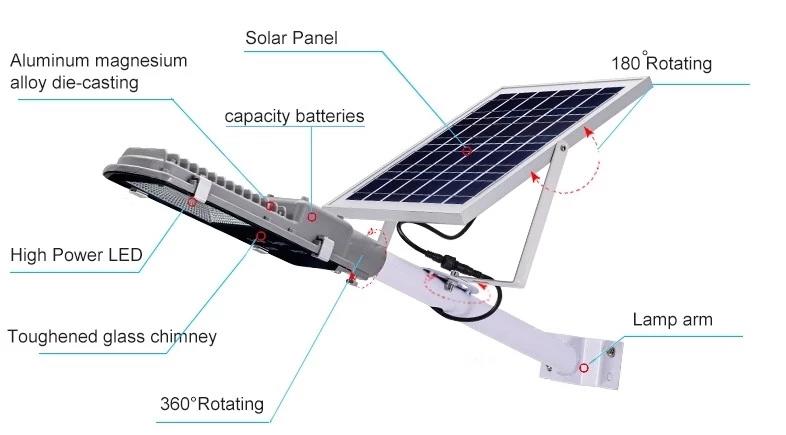Solar street lights consist of several structural components that work together to provide lighting powered by solar energy. The specific design and arrangement of these parts can vary among different models and manufacturers. Here are the common structural parts of solar street lights:
- Solar Panel: The solar panel is a key component that converts sunlight into electrical energy. It’s usually mounted on top of the street light’s pole or fixture and consists of multiple solar cells that generate direct current (DC) electricity.
- LED Fixture/Lamp: The LED fixture or lamp is responsible for providing illumination. LEDs (Light Emitting Diodes) are energy-efficient and offer a long lifespan. They are often integrated into a fixture designed to distribute light effectively over the designated area.
- Battery: The battery stores the energy generated by the solar panel during the day, allowing the street light to operate at night or during periods of low sunlight. Batteries used in solar street lights are typically rechargeable and designed to withstand charge and discharge cycles.
- Controller: The controller regulates the overall operation of the solar street light system. It manages the battery charging process, turns the light on and off based on ambient light levels or user settings, and can include additional features like dimming and timing control.
- Pole: The pole provides structural support for the entire solar street light system. It’s often made of durable materials like steel or aluminum. The pole’s height and design can vary depending on the intended application and illumination requirements.
- Battery Box: The battery box houses the battery and controller. It protects these components from weather elements and provides a secure and controlled environment for their operation.
- Fixture Housing: The housing of the LED fixture protects the LED modules and other internal components from environmental factors like moisture, dust, and insects. It’s designed to efficiently disperse light and prevent glare.
- Solar Panel Mounting Bracket: This bracket secures the solar panel to the pole or fixture. It ensures the solar panel is oriented towards the sun for maximum sunlight exposure.
- Reflectors/Optics: Some solar street lights feature reflectors or optics that help distribute light more efficiently and uniformly, enhancing the overall lighting performance.
- Lamp Arm/Extension: In some designs, the lamp arm or extension provides additional flexibility to adjust the angle and direction of the LED fixture for optimal lighting coverage.
- Base/Foundation: The base or foundation of the pole provides stability and anchoring to the ground. It helps support the weight of the entire system and ensures the street light remains upright.
- Wiring and Connectors: Various wiring and connectors connect the components of the solar street light system, such as connecting the solar panel to the battery and controller, as well as linking the controller to the LED fixture.
- Photovoltaic Mounting System: In ground-mounted solar street light systems, a photovoltaic (PV) mounting system holds the solar panels securely and positions them at the optimal angle for sunlight exposure.
It’s important to note that the design and features of solar street lights can vary, especially with advancements in technology and customization options. When evaluating different models, make sure to consider the quality of each component and how well they integrate to provide efficient and reliable lighting.


